Research shows that skilled divers who dive without oxygen can tolerate a drop in heart rate of '11 times a minute'

Dive into the deep sea do not use, such as oxygen tank to breathe
When the human brain goes diving: using near-infrared spectroscopy to measure cerebral and systemic cardiovascular responses to deep, breath-hold diving in elite freedivers | Philosophical Transactions of the Royal Society B: Biological Sciences
https://doi.org/10.1098/rstb.2020.0349
Divers beat seals during deep dives | University of St Andrews news
https://news.st-andrews.ac.uk/archive/divers-beat-seals-during-deep-dives/
Free divers' heart rates can drop as low as 11 beats per minute | Live Science
https://www.livescience.com/divers-brain-oxygen-level-lower-seals.html
Experienced freedivers can hold their breath for more than 4 minutes and dive to a depth of more than 100m. However, there is also a risk of losing consciousness because oxygen cannot be taken into the body during a breath-holding dive, which impairs the ability to deliver oxygen throughout the body through the blood. According to Erika Schagatay of the University of Mid-Swedish, who has been studying freedivers for 30 years, 'Because the research so far was done in simulated diving in the laboratory, it is an exceptional diver who dives in deep sea. I couldn't understand the effects on the brain and cardiovascular system and how much these divers are overworking the body, 'he said, and it's unclear what's happening inside the freediver's body. Many points were left.
Therefore, international research teams in Sweden, the United Kingdom, the Netherlands, Japan, etc. have used near-infrared spectroscopy (NIRS) , which measures changes in oxygen saturation by irradiating a living body with near-infrared rays, to saturate oxygen in blood and brain. We have developed a special device called 'Artinis Medical Systems' that measures the degree and heart rate. Artinis Medical Systems is a wearable device that irradiates the skin with LED light, and can withstand extremely strong water pressure at high depths. The research team wore this device on the head of a freediver and conducted an experiment in which they were asked to dive to a depth of 100 m or more while measuring heart rate and blood oxygen saturation.
Actually, you can see how the freediver who cooperated with the research team dives to a depth of 100 m or more by watching the following movie.
When the human brain goes diving --YouTube
The numbers on the right indicate 'heart rate', 'blood oxygen saturation', and 'brain oxygen saturation' from the top. The heart rate at the start is 60bpm, blood oxygen saturation is 99%, and the brain's oxygen saturation. Oxygen saturation is 70%.
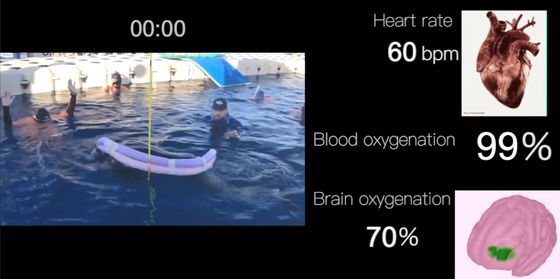
When the dive begins, your heart rate begins to decrease. This is due to the body's adaptive system working to keep blood oxygen saturation.
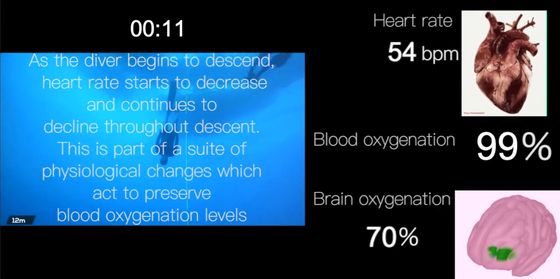
In 50 seconds after starting the dive, it reached a depth exceeding the Colosseum (height 48 m) in Rome. At this point the heart rate has dropped to 42 bpm.
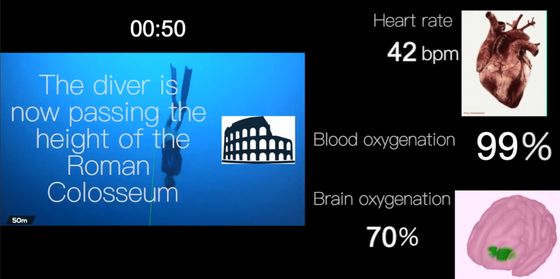
Gradually, the diver stops fluttering and dives like a free fall. At 1 minute and 35 seconds after the start of the dive, the water depth reached 87 m and the heart rate was 36 bpm. Blood oxygen saturation is 99%, but brain oxygen saturation is reduced to 65%.
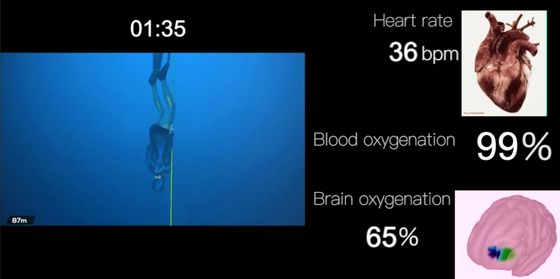
Finally, the water depth exceeded 100m, and the heart rate dropped to 30bpm. This is still a low enough number, but in some cases the heart rate dropped to 11bpm.
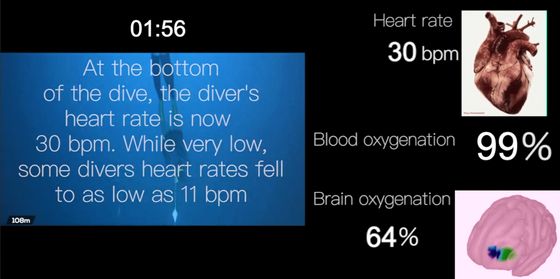
When the diver reached the turning point and began to ascend, his heart rate rose at a stretch to 60 bpm. On the other hand, blood oxygen saturation and brain oxygen saturation begin to decrease rapidly.
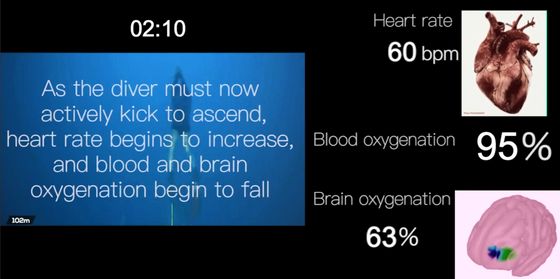
Three minutes after the start of the dive, the diver has risen to a depth of 66m, which is a total of nearly 140m up and down. The heart rate is 66 bpm, blood oxygen saturation is 81%, and brain oxygen saturation is 60%.

When the diver ascended to a depth of 40m, the oxygen saturation in the brain finally fell below 50%. According to the research team, you can lose consciousness when your brain's oxygen saturation drops below 50%.
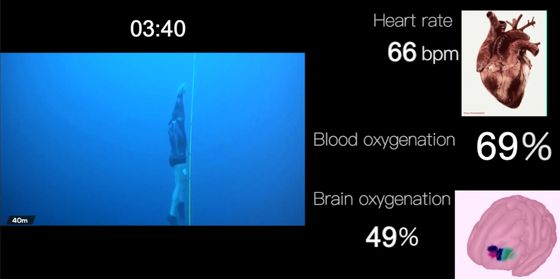
At a depth of 30m, safety divers who support the divers to safely rise to the surface of the water join. In freediving, there is a high risk at the time of ascent when blood oxygen saturation decreases, especially at the last step.

At 4 minutes and 13 seconds after the start of the dive, the heart rate was 66 bpm, the blood oxygen saturation was 59%, and the brain oxygen saturation was 36%. It seems that this is a level at which cerebral dysfunction can occur.
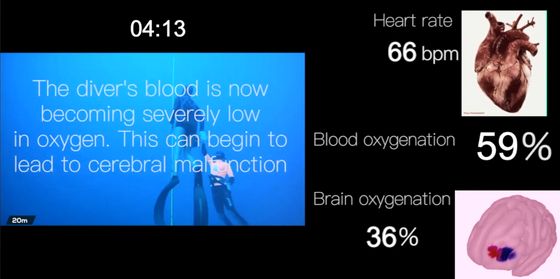
Immediately before appearing on the surface of the water, the oxygen saturation of the diver's brain dropped to nearly 25%. This is lower than the diving seals and corresponds to the lowest measured at the summit of Everest, the researchers say.
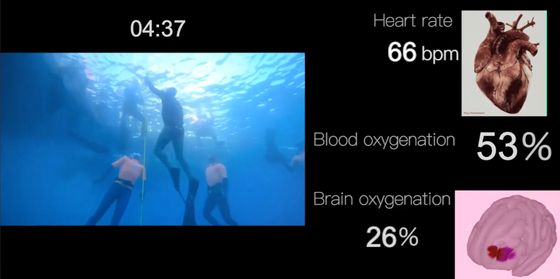
This diver was able to ascend to the surface of the water safely.
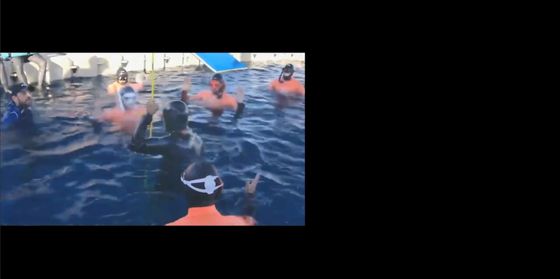
Dr. Chris McKnight of the University of St Andrews, the lead author of the paper, said, 'Beyond the extraordinary physiological response and patience that freedivers show, they may be a very beneficial physiological group. Physiological responses are so unique that they cannot easily reproduce the situation they are exposed to, so they are a special way to understand the body's response to low oxygen levels in the blood and brain and severe cardiovascular suppression. Will provide. ' According to the research team, the findings will help freedivers become safer and may help them understand how to protect the heart and brain of traumatized and surgically treated patients.
Related Posts:







